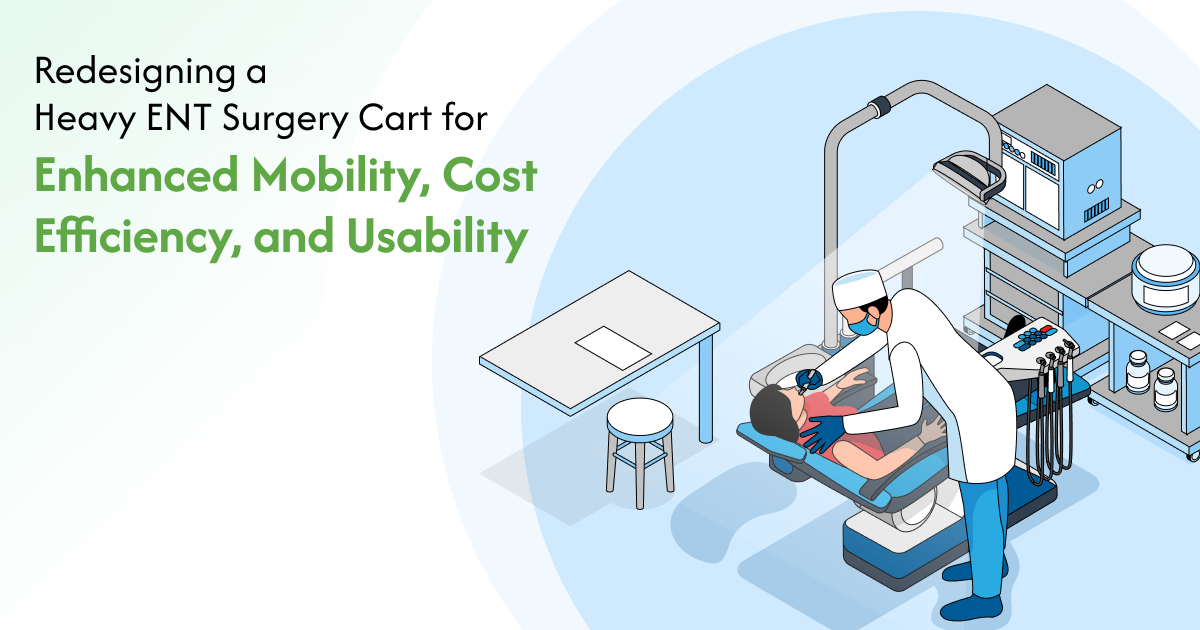
At Katalyst Engineering Services, we continually strive to drive innovation by deftly utilizing these resources, changing the issues encountered by various industries and fields with potential solutions.

At Katalyst Engineering Services, we continually strive to drive innovation by deftly utilizing these resources, changing the issues encountered by various industries and fields with potential solutions.

A global medical equipment manufacturer, specializing in ENT (Ear, Nose, and Throat) surgical devices, approached Katalyst Engineering with a pressing challenge. The client’s existing ENT surgery cart was excessively heavy, difficult to maneuver in operating rooms, and costly to produce at scale. These limitations hindered both operational efficiency in hospitals and the manufacturer’s ability to meet competitive pricing demands.
The original ENT surgery cart presented several pain points:
The client required a complete redesign that would address all these issues while ensuring regulatory compliance and maintaining product durability.
Katalyst Engineering implemented a three-phase approach combining reverse engineering, lightweight design strategies, and cost-focused manufacturing optimization.
Phase 1 – Product Assessment & Reverse Engineering
Our engineers performed a detailed teardown of the existing cart to identify weight-heavy components, redundant materials, and design inefficiencies. Through 3D scanning and CAD modeling, the existing structure was reimagined for improved structural integrity with reduced bulk.
Phase 2 – Lightweight & Ergonomic Redesign
We adopted high-strength lightweight materials, such as aluminum alloys and reinforced composites, reducing the cart’s weight significantly without compromising durability.
Phase 3 – Design for Manufacturing (DFM) Optimization
To ensure the redesign was cost-efficient and scalable, we applied DFM principles:
1. Weight Reduction by 30%
The cart became significantly lighter, easing transport between operating theaters and reducing physical strain on medical staff.
2. 20% Cost Savings in Production
Through material optimization and streamlined manufacturing, the client achieved sustainable cost benefits across all production batches.
3. Enhanced User Experience
Surgeons and operating room staff reported improved mobility, faster setup times, and better access to essential surgical tools.
4. Modular Design Advantage
The redesigned cart now supports custom configurations, enabling the manufacturer to cater to diverse hospital needs without separate product lines.
5. Compliance & Global Readiness
The final product met international medical equipment standards, allowing the client to launch across multiple regions without design modifications.
This project is a showcase of Katalyst Engineering’s medical device engineering expertise — where precision engineering, cost control, and user-focused design come together. Our end-to-end product development process not only transformed the cart into a lightweight, ergonomic, and cost-effective solution but also future-proofed it for upcoming medical innovations.
By leveraging reverse engineering and DFM best practices, we helped the client:
The redesign of the heavy ENT surgery cart is a testament to Katalyst Engineering’s ability to blend engineering innovation, cost optimization, and ergonomic excellence. By applying reverse engineering techniques, lightweight material strategies, and Design for Manufacturing best practices, the team delivered a high-performance, cost-effective solution that meets the demands of modern surgical environments.
This project not only resolved the immediate challenges of weight, mobility, and production costs but also positioned the client for long-term success with a modular, globally scalable product design. In an industry where precision and usability directly impact patient care, Katalyst Engineering once again proved its role as a trusted partner in medical device engineering.
Need help understanding our services in depth? Our team of experts will specify everything you require. Tap on the Contact Us button and connect with our team today!
